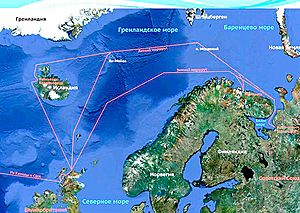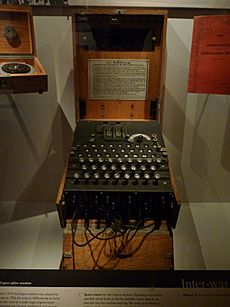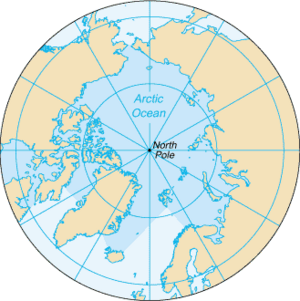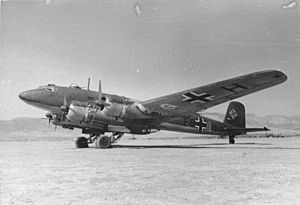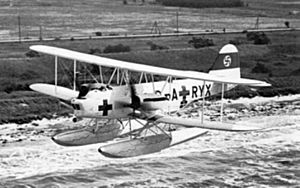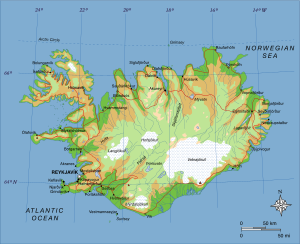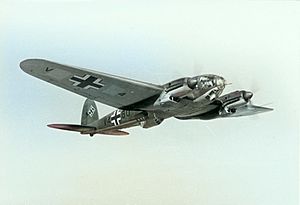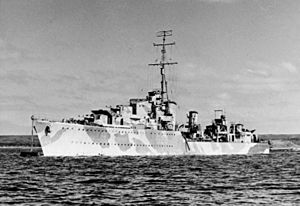Convoy PQ 8 facts for kids
Quick facts for kids Second World War |
|||||||
|---|---|---|---|---|---|---|---|
| Part of Arctic Convoys | |||||||
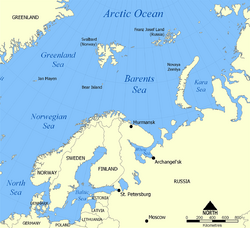 The Norwegian and the Barents seas, site of the Arctic convoys |
|||||||
|
|||||||
| Belligerents | |||||||
| Commanders and leaders | |||||||
| Escorts: L. S. Saunders Convoy: R. W. Brundle |
Hans-Jürgen Stumpff | ||||||
| Casualties and losses | |||||||
| 1 destroyer sunk 1 merchantman damaged |
|||||||
Convoy PQ 8 was a group of ships that sailed together for safety during World War II. This particular convoy traveled through the Arctic Ocean to deliver important supplies to the Soviet Union. It left Iceland on January 8, 1942. The journey was tough, with dangers from ice and German attacks. Nine days later, the convoy reached Murmansk, a port in Russia.
On January 17, 1942, a German U-boat (submarine) called U-454 attacked the convoy. It damaged a merchant ship named SS Harmatris. The U-boat also sank the destroyer HMS Matabele. Almost everyone on the Matabele was lost. The rest of the convoy made it to Murmansk that day. The damaged Harmatris was towed into the harbor a few days later.
The Harmatris stayed in Russia for a long time. Bad winter weather, a lack of workers, and frequent German air attacks made repairs difficult. It finally sailed home with another convoy in September 1942.
Contents
Why Convoys Sailed to Russia
Helping an Ally: Lend-Lease
When Germany invaded the Soviet Union in June 1941, Britain and the Soviets became allies. They agreed to help each other fight Germany. Britain sent many supplies, like aircraft, rubber, and boots. The United States also joined in, sending aid through a program called Lend-Lease.
The Soviets needed a lot of military gear. Their factories were being moved to safer places, which slowed down production. So, Britain and the US promised to send hundreds of planes and tanks each month. They also sent raw materials, food, and medical supplies. These goods were vital for the Soviet war effort.
British War Plans
The British military leaders faced a big challenge. German air power in Norway was growing stronger. Also, a powerful German battleship, the Tirpitz, arrived in Norway in early 1942. These threats made the Arctic convoys very risky. Some British admirals thought about stopping the convoys during the summer.
The British also had a secret weapon: code-breaking. At a place called Bletchley Park, British experts could read German secret messages. They could often tell where German ships and U-boats were. This helped the convoys avoid danger. German forces also tried to break British codes. This was a constant battle of wits.
The Arctic Ocean Challenge
The waters between Greenland and Norway are some of the stormiest in the world. Ships faced strong gales, snow, and sleet. The cold Arctic water mixed with warmer water from the Gulf Stream. This created thick fog, which could hide convoys but also made it hard for ships to use their sonar (ASDIC) to find U-boats.
In winter, the sea was covered in ice far to the south. The area was also in total darkness during winter. This made it very hard for planes to scout for ships. The water was so cold that anyone falling in would die quickly without rescue. Ice also built up on ships, making them top-heavy and dangerous. U-boats had their own problems with ice and freezing equipment.
German Preparations
In 1941, Adolf Hitler ordered more German U-boats to move to Norway. By early 1942, many U-boats were based there. The battleship Tirpitz also arrived in Norway in January 1942. At first, the Germans didn't pay much attention to the Arctic convoys. They were small, and the long winter nights made attacks difficult.
German Air Force (Luftflotte 5)
Germany's Air Fleet 5 was in charge of air operations in Norway. They had about 180 aircraft. However, many were used for other battles. The planes that remained for Arctic operations were few. The weather also made flying very difficult. The German air commander, Hans-Jürgen Stumpff, wanted more planes for sea rescue. He knew that aircrews needed a chance of rescue if they crashed in the freezing waters.
The German Sea Rescue Service worked with the navy to save aircrews and sailors. They used special floatplanes and seaplanes. But there weren't enough rescue aircraft. This made it even more dangerous for German pilots flying over the Arctic.
The Arctic Convoys
In October 1941, British Prime Minister Winston Churchill promised to send a convoy to Russia every ten days. These convoys carried tanks, aircraft, and other goods. Ships from Britain, the US, and other Allied countries gathered in Iceland. From there, they sailed in groups, or convoys, for safety.
A special officer, called a convoy commodore, led each convoy. He made sure the ships stayed in formation. They sailed in long rows, keeping a safe distance from each other. By late 1941, these convoys had delivered many tanks and planes to the Soviet Union. These supplies helped the Soviets defend against the German invasion.
Convoy PQ 8 Ships
Convoy PQ 8 had eight merchant ships. These included British tankers and cargo ships, a Soviet ship, and two US ships. The convoy left Scotland on December 28, 1941, and arrived in Iceland on January 1, 1942.
The convoy had a close escort of two minesweepers, HMS Harrier and Speedwell. On January 11, they were joined by a larger escort. This group included the destroyers HMS Matabele and Somali, and the cruiser HMS Trinidad.
The Voyage of PQ 8
January 8–16
Convoy PQ 8 left Iceland on January 8, 1942. The weather was good at first. On January 12, the ships had to turn south to avoid thick ice. The sea was calm, and visibility was excellent. The German navy had set up its first "wolfpack" of U-boats in the Arctic. These three U-boats, including U-454, were looking for the convoy.
January 17: The Attack
Even in the dark Arctic night, German planes and U-boats struggled to find PQ 8. But on January 17, the convoy was sailing south. At about 6:00 a.m., U-454 attacked a Russian fishing trawler, the RT-68 Enisej. It sank the trawler, killing two men.
Later that evening, at 7:45 p.m., U-454 found Convoy PQ 8. It fired a torpedo at the merchant ship Harmatris. The torpedo hit the front of the ship. Luckily, the torpedoes inside the Harmatris's cargo hold did not explode. The crew was ordered to abandon ship. The destroyer Matabele heard the torpedo on its sonar.
The destroyers searched for the U-boat, but couldn't find it. The Speedwell stayed near the damaged Harmatris. The rest of the convoy sailed on. An hour later, U-454 fired another torpedo at Harmatris. This one also failed to explode. The Speedwell took the crew off the Harmatris.
Later that night, U-454 fired torpedoes at a tanker, the British Pride. The torpedoes missed the tanker but one hit the destroyer Matabele. The Matabele exploded and sank quickly. Only two men, William Burras and Ernest Higgins, survived. The rest of the crew died from the explosion or the freezing water. The other ships scattered, but soon regrouped and continued their journey.
January 18–19: Towing the Harmatris
The crew of Harmatris returned to their ship the next morning. They found that the ship's equipment was frozen. They worked to free the anchor cable. Finally, the Speedwell began to tow the Harmatris. Two other minesweepers, Sharpshooter and Hazard, joined them.
Around noon, a German Heinkel He 111 bomber attacked the ships. It fired at Harmatris but was hit by anti-aircraft fire and flew away smoking. An hour later, a Junkers Ju 88 bomber attacked. Its bombs missed, and it too was hit by gunfire. At 2:30 p.m., a steam pipe on Speedwell burst, injuring three men. A Soviet tugboat arrived and took over towing Harmatris. Two more tugs arrived on January 19.
January 20: Arrival in Murmansk
The German navy had planned to attack the convoy with the battleship Tirpitz. But they didn't have enough fuel or escort ships, so the attack was called off. With the help of the tugs, the Harmatris finally arrived in Murmansk at 2:00 p.m. on January 20. The ship was badly damaged, with a large hole in its side.
After the Battle
Future Convoys
The next convoys, PQ 9, PQ 10, and PQ 11, made it through safely. However, as the days grew longer, the convoys became more vulnerable to German attacks. British commanders felt that the Russians needed to do more to protect the convoys as they neared their destination.
Harmatris' Repairs
The Harmatris had reached Murmansk, but the port was not ready for so many ships. It was also bombed frequently by the German air force. It took three days just to clear the ice from the ship's steam pipes. The cargo was unloaded by February 4. Much of it was undamaged, but some sugar and trucks were lost.
The ship then waited for dry-dock repairs. There was a huge hole in its side, and many parts were damaged. It was very hard to find spare parts or workers. The crew had to search other ships for parts. The intense cold also made work difficult. The Harmatris was even moved out of the dry dock to make room for a destroyer.
The crew of Harmatris decided to work at night to avoid the frequent air raids. The port was attacked thirty times while they were there. Food was also very scarce. The crew even rowed out to sunken ships to find canned food. Finally, on July 21, Harmatris sailed to another port, Archangelsk. It took on steel pipes and survivors from other convoys. On September 13, 1942, the Harmatris finally sailed for Britain with Convoy QP 14.
Convoy PQ 8 Ships
Merchant Ships
| Ship | Year Built | Flag | Size (GRT) | Column No. | Notes |
|---|---|---|---|---|---|
| British Pride | 1931 | 7,106 | 22 | Tanker, arrived on January 17 | |
| British Workman | 1922 | 6,994 | 32 | Tanker, arrived on January 17 | |
| Dartford | 1930 | 4,093 | 12 | Arrived on January 17 | |
| El Almirante | 1917 | 5,248 | 11 | Arrived on January 17 | |
| Harmatris | 1932 | 5,395 | 31 | Convoy leader's ship; torpedoed, towed to port by HMS Speedwell and Soviet tugs, arrived January 20 | |
| Larranga | 1917 | 3,804 | 21 | Vice-convoy leader's ship, took over from Harmatris and arrived January 17 | |
| Southgate | 1926 | 4,862 | 41 | Arrived on January 17 | |
| Starii Bolshevik | 1933 | 3,974 | 42 | Arrived on January 17 |
Escort Ships
| Name | Flag | Type | Notes |
|---|---|---|---|
| HMS Harrier | Minesweeper | Escort January 8–17 | |
| HMS Hazard | Minesweeper | Escort January 16–17 | |
| HMS Matabele | Destroyer | Escort January 11–17, torpedoed and sunk by U-454 on January 17, two survivors | |
| HMS Sharpshooter | Minesweeper | Escort January 16–17 | |
| HMS Somali | Destroyer | Escort January 11–17 | |
| HMS Speedwell | Minesweeper | Escort January 8–17 | |
| HMS Trinidad | Cruiser | Escort January 11–17 |


